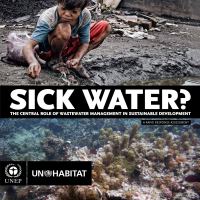

49
Population growth
The world’s population is expected to grow by almost a third to
over 9 billion people in the next 40 years (UNFPA, 2009), result-
ing in increased water usage, and increased demand for food and
products. The amount of available fresh water resources, how-
ever will not increase. Over the period to 2050 the world’s water
will have to support the agricultural systems that will feed and
create livelihoods for an additional 2.7 billion people (UN, 2010).
Urban populations are projected to see the fastest growth rising
from a current 3.4 billion to over 6.4 billion by 2050 (UNDESA,
2008). Most cities in developing countries have an aging, in-
adequate or even non-existent sewage infrastructure, unable
to keep up with rising population. Effective treatment also re-
quires a transportation infrastructure to deal with the growing
masses and frequently unorganized settlement patterns.
Slum dwellers of the new millennium are no longer a few thou-
sand in a few cities of a rapidly industrializing continent, but
include one out of every three city dwellers, close to a billion
people, or a sixth of the world’s population and are projected to
increase to 1.4 billion within a decade (UN-HABITAT 2009),
meaning another 400 million people without basic sanitation
or water supply by 2020. Over 90 per cent of slum dwellers to-
day are in the developing world. In sub-Saharan Africa, urban-
WASTEWATER AND GLOBAL CHANGE
ization has become virtually synonymous with slum growth.
The slum population of sub-Saharan Africa almost doubled in
15 years, reaching nearly 200 million in 2005. Seventy-two per
cent of the region’s urban population lives under slum condi-
tions, compared to 56 per cent in South Asia. (UNFPA, 2007)
As cities continue to expand their size, footprint and slum ar-
eas, it is essential that wastewater management is brought into
urban management and planning. Currently one fifth or 1.2
billion people live in areas of physical water scarcity. It is esti-
mated that this will increase to 3 billion by 2025 as water stress
and populations increase (UNDP, 2006 and DFID,2008)
Climate change
The relationship between wastewater and climate change can
be seen from three perspectives. Changing climatic conditions
change the volume and quality of water availability in both time
and space, thus influencing water usage practices. Secondly
changes in climate will also require adaptation, in terms of how
wastewater is managed. Finally, wastewater treatment results
in the emission of greenhouse gases, particularly carbon diox-
ide (CO
2
) and methane (CH
4
) and nitrous oxide (N
2
O).
Changes to global climate patterns are a reality which impacts
our daily lives (IPCC, 2007) and may affect water availability,
Global populations are rapidly expanding with urban populations expected to double in
the next 40 years (UNFPA, 2009), increasing demands on food and water resources and
already inadequate wastewater infrastructure. This is in the light of changing climatic
patterns, and water availability, weakened ecosystems and inconsistent and poorly in-
tegrated management. The challenges that unmanaged wastewater poses in the urban
environment, to food production, industry, human health and the environment are in-
terconnected and becoming ever more severe. It is critical that wastewater management
is dealt with urgently and given very high priority to become an integral part of urban
planning and integrated watershed and coastal management.

















